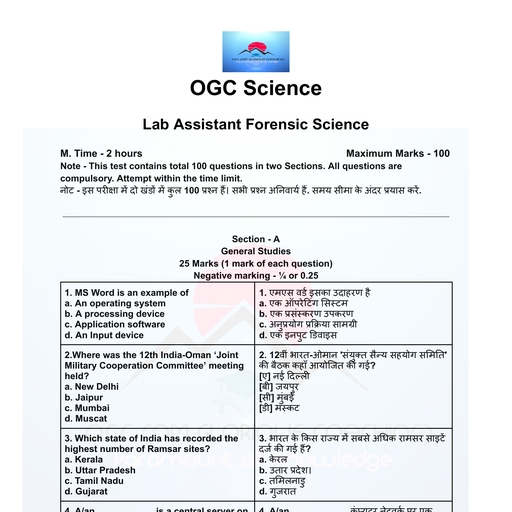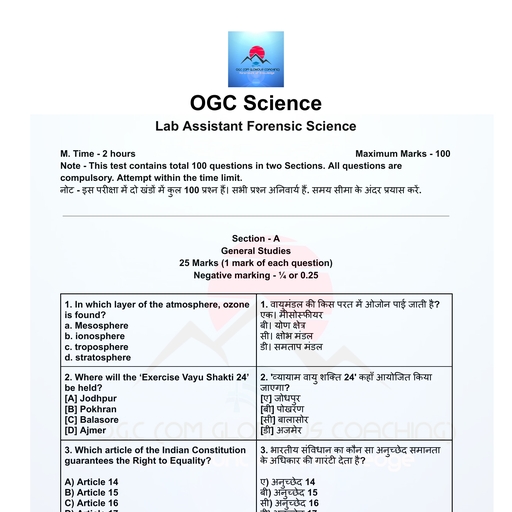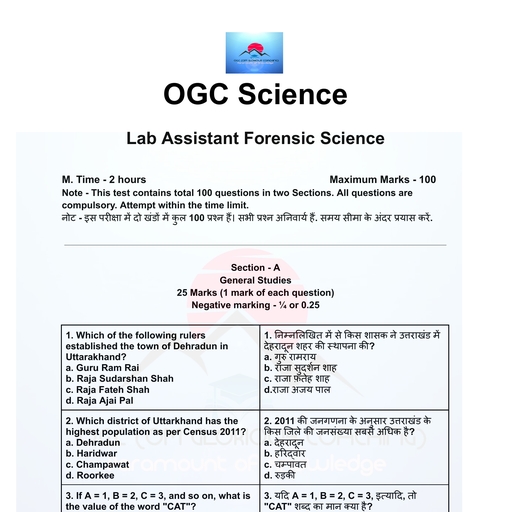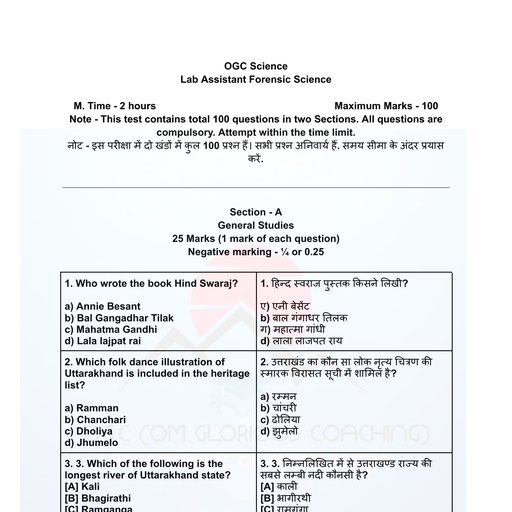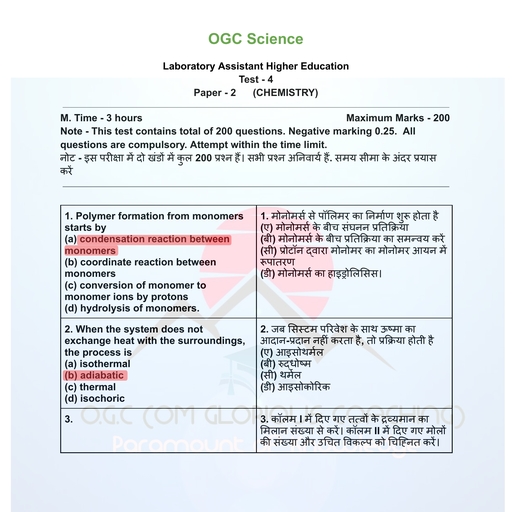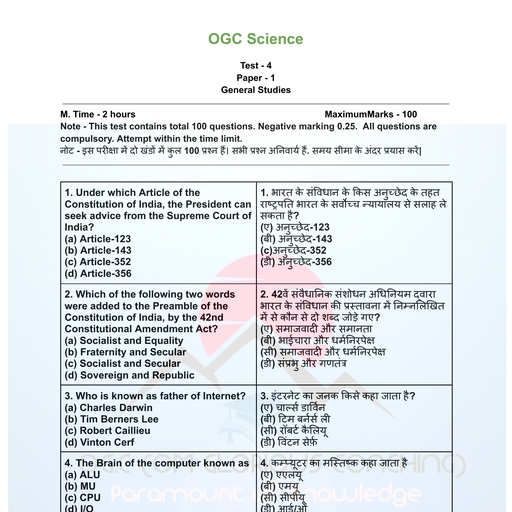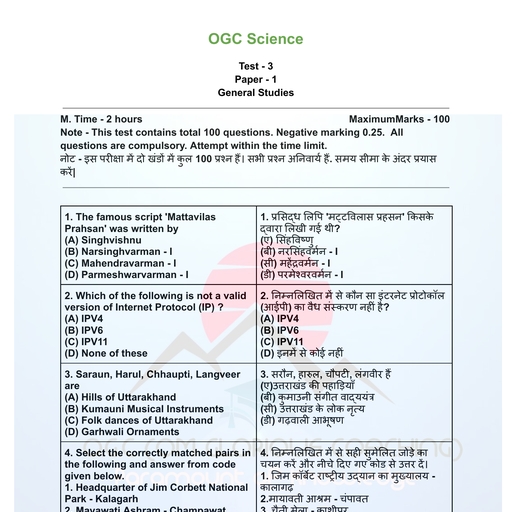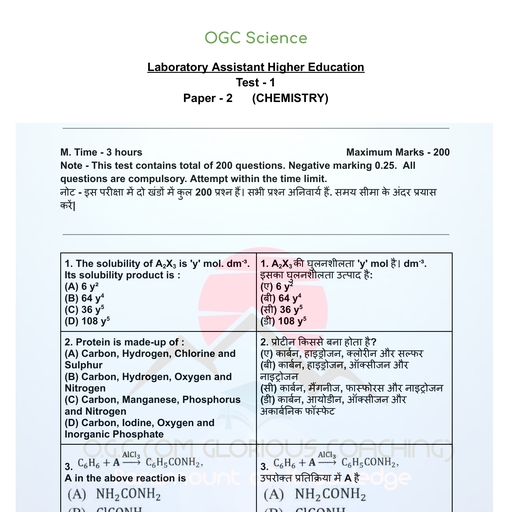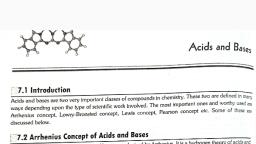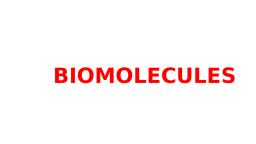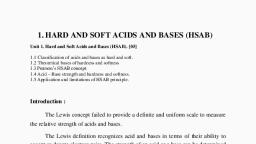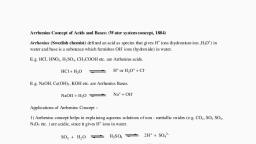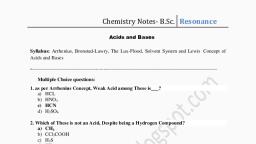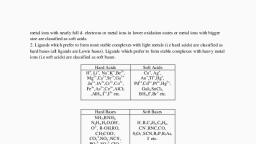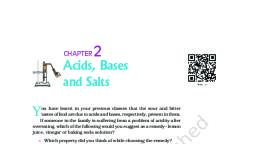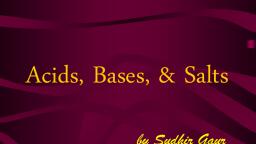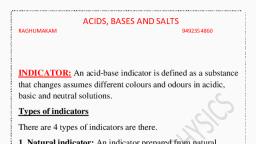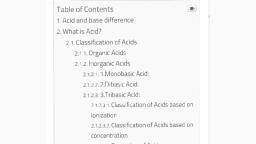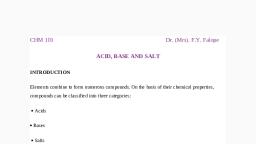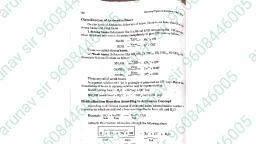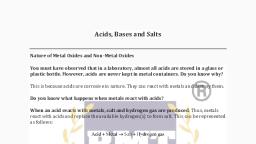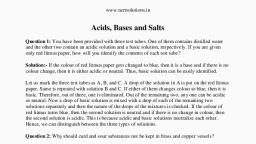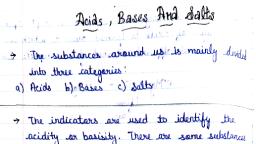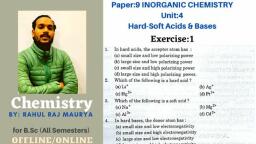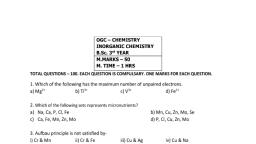Page 1 :
7, , Hard and Soft, , Acids, and Bases (HSAB), , Guilabus: Classification, , of, , acids and bases, , hard and soft,, HSAB concept, acid-base, and, strength, hardness and, , as, Paarson's, Softness, Symbiosis, heorebical basis of hardness and softness,, , electro negativity and hardness and softness., , 7.1. Classification of Lewis Acids as Hard and Soft Acids, , R.G Pearson (1963) classified Lewis acids and bases as hard and, soft acids and bases. This classification is mainly based upon the, neutral, polarizing power and polarizibility of cations, anions and those, in, molecales. The acids or bases whose characteristics are between, as borderline acids or borderline, of hard and soft acids or bases are called, bases. The, , and classification, main characteristics, , of Lewis acids and, , bases are as follows, , 1. Lewis acids, , a pair of, , electrons, , acids may, , be, , : The cations or, , are, , as, , Lewis acids. According, , classified as, , (a) Hard acids:, the, , called, , neutral molecules, , acceptor atom, , These are, , the cations or, , which can accept, to, , Pearson, these, , in which, , neutral molecules, , has:, , (i) small size,, positive, , oxidation state,, , high, (i) high polarizing, , (), , (V) low, , power,, , põlarizibility,, , i.e.. its, , easily polarized., mportant, SomeC iim, ),, Li. Na", K*),, , examples, , alkaline, , lighter transitio, , ransition, , electrons or, , metal ions, , outer, , ofhardacids, , earth, , metal, , (eg.,, , not, d-orbitals are, , ions, , Cr",, , (221), , are, , alkali, , (eg.,, , Fe",, , metal ions (eg.,, , Be*,, , Mg*, Ca2*),, , Co" etc.).
Page 2 :
222, , organic Chemistry(b), , the, , Soft acids: These, , acceptor atom has, large size,, , the, , are, , the cations, or neutral, , following characteristics, , molecules in, , which, , (ii) low positive oxidation state,, (iii) low polarizing power,, , (iv) high, , polarizibility,, , i.e.,, , its outer, , easily polarized., , or, , d-orbitals, rbitals are, a, , Some important examples of soft acids, ions in lower oxidation states such as Cu',, , Hg2, , electrons, , etc., , are, , heaviér transition metol, , Ag', Au Hg,*", ca2, , classification of these acids as hard, soft and, (intermediate) categories is given in the following table : borderline, The, , Classification of Acids, , Hard Acids, , Borderline Acids, , H', Li, Na*, K*, Be2*, Fe2, Co, Ni2*,, Cu,, Mg, Ca, Sc*, La*, | Zn2*, Os*, Ru?*, Sn**., , Ti, CrFe, Co,, Al, BF, BCI, AICl,., , Pb2*, Sb*, Bi*, sO,, , Cu, Ag',Au'Au,, , Ca*.Hg, Hg., , Pd2*, Pt*, TI', P*,, , GaCl,, carbenes, I',, , CO,, Si+, Sn*,, , Br, zero valent metal, , Te,, 7.2., , Soft Acids, , atoms., , Classification of Lewis Bases as Hard and Soft Bases, The anions or neutral molecules which can, donate a pair of, , electrons are called as Lewis bases. According to Pearson, these bases, , may be classified as, (a) Hard bases: These are the anions or neutral molecules in which, the, , donor atom, , has the, , () small size,, , following characteristics, , (i) high electronegativity,, (ii) low polarizibility, i.e., outer electrons or orbitals are not easiuy, , polarized., oOne inmportant examples of hard bases are: OH, NHj:, , 2N2, H,0, CH,COO, hard acids., , etc., , The hard bases prefer to, , combine wi
Page 3 :
ACIaS and Bases, , and Bases (HSAB), HSAB), (b) oft bases: These are the, anions or, donor, atom has the following, neutral, ), , haracteristics, , large size,, , 223, , molecules in which, , (ii) low electronegativity,, , (i) high polarizibility i.e., its, outer, , electrons or orbitals are, polarized., easily, Some important example of soft, bases are H,, The soft bases prefer, CN, CO, I, etc., to, , combine, , sofacids. It is seen that in a group, periodic table, the softnesswith, of the Lewis, base increases as, of the donor atom increases., Ihus, among the halides softness the size, in the order F <CI< Br < T. Thus,, increases, F is the hardest and I is, af the, , softest Lewis base among the halides., The classification of these bases, , the, , as, , hard, soft and borderline, , (intermediate) categories is given in the following table., Classification of Acids, Hard Bases, , Borderline Bases, , NH,, R-NH, N,H,, , CHNH, , Soft Bases, , C.H,N, NO;, |H, RSH, RS", S*,, , H0, OH, CH,CO0, SO,Br, , CN, CH CO, SCN,, , RO, 0, R-OH,, , S,0TCH,.CH,, , ROR, CO , NO, SO, F. C7, 0, , 3 . Choose Hard and Soft Acids with Explanation from the, , Given Acids, AFe", Ag', Co*, Ca*, T1*, Se*, Pa*, Au",, , Hard acids: Li', A13*, Fe*, Co,Ca*,Ti",Sc, , Soft acids: Ag', Pd*, Au*,I, , According to, molecules, , acids, Pearson, the hard, the acceptor atom has, , are, , cations, , or neutral, , in which, polarizing, ) small size,, oxidation state, (ii) high, not, (ii) high positive, orbitals are, or, power, (iv) low polarizibility, electrons, i.e, its outer, easily, easily nol, polarized. po, in, neutral molecules, , which tne, , low, state, (il), largesize, (i) low positive oxidationelectrons, or, (iv) high polarizibility i.e., its outer, , polarizing, , Cceptor ato acids, , acceptor atom has, , eas:, easily polarized., , are, , the cations, , or, , are
Page 4 :
224, , 7.4,, , Inorganic Chemistry-lI, , Classification of Some Bases as Hard, Soft or Border Line, NH,I,0,, ROH, CO, C,H,, S*, N,H,, CN,0, NO;,, CH,N, F, Br, , Hard bases: NH,O, ROH, N,H,0, NO;, F, , Soft bases: I,CO, CHg, S*, CN, Border line bases : C,H,N, Br, 7.5. Principle of Hard and Soft Acids and Bases, (HSAB Principle), and, Soft, Principle of Hard, Acids and Bases (HSAB, Pearson gave a simple rule to explain the stability of acid basePrinciple):, reactions., His concept is known as principle of hard and soft, acids and bases., to, this, a, According, principle hard acid always prefers to combine with a, hard base while a soft acid prefers to combine with a, sofi base Thus, a, complex AB is most stable when both A and B are either hard or soft., B:, A, , species, , will not be stable., , 7.6., , Complex, , (electron pair acceptor), , (electron pair donor), If one of the, , BA, , Lewis acid, , Lewis base, , is hard and other is soft, the, , complex formed, , Applications, , of HSAB Principle, Hard and soft acid-base principle has several important, applications, which are as follows, , 1.(a) Stability of complexes having same ligand: Pearson (1963), explained the relative stability of complexes on the basis of hard and soft, acid-base principle. Thus, a complex AB is most stable when both A and, B are either hard or soft., , B:, , +, , Lewis base, , (electron pair donor), , BA, Complex, , A, , Lewis acid, , (electron pair acceptor), , If one of the species is hard and other is soft, the complex formed, will not be stable. For example, Agl, is stable whereas AgF; is unstable., This is because Agl, is formed by the combination of Ag' ion (soft acid, and I ion (soft, , base) whereas AgF, , is formed by the combination, , ion (soft acid) andF ion (hard base), +, 21, Ag, soft acid o f t base, , Agl, stable, , of Ag
Page 5 :
and Soft Acids and Bases (HSAB), , Hard, , 225, , Ag, , 2F, , soft acid, , AgF, , hard base, , Similarly, [CoF,J* ion (Co*, stable, [C, hle whereas, whereas[Col,ion, (Co, unstable., , Co, , unstable, , ion hard acid and F, ion hard base) is, ion hard acid, and I ion soft base) is, , 6F, , hard acid, , [CoF,), , hard base, , Co, hard acid, , stable, , 61, , +, , [Col,}, , soft base, , unstable, , Among the complex [Cd(CN), 1, , and [Cd(NH,),1* ions, the, , former is stable due to its formation by soft acid and soft base whereas, , latter is unstable due to its formation by soft acid and hard base., Cd2, , > [Cd(CN),, , 4CN, , +, , soft acid, , soft base, , Ca2, , 4NH, , stable, , [Ca(NH,)., unstable, , hard base, , soft acid, , different ligands : If, , (b) Stability of complex compounds havingof, , ligands attached to, has more than one type, compound, complex, different, decreased if one ligand is of, central metal ion, its stability is, , a, , nature, , ), , For example., compared to others., is stable, [Co(NH,),F]*" complex, , as, , complex is unstable., , This is, , [Co(NH,,F]*, , is, , hard acid, , NH,hard base, Isoft base, , NH, hard base, hard base, , complex is, , (i) [Co(CN),I, Oecause ofthe, gands, , same, , nature, , have different, , of CN, , nature., , complex., hard base in another, , ICo(CN),1, Co, , hard acid, , stable, , F1*., than [Co(CN),, , This is, , CN and, ion is a, , (soft bases)., and I ligands, whereas F, , CN ion is a, , soft base, , [Co(CN),F, Co, , hard acid, , C N s o f tbase y l u r u e, , CN S o f t base., , Isoft base, , a, , [Co(NH,),*, Co, , hard acid, , F, , [Co(NH,),*, , and, hard acid. Both NH,, on the basis of, is soft base. Therefore,, stable than the later., former complex is, , because Co*, , whereas I, Fare hard bases, the, hard-soft acid base principle,, , Co, , whereas, , hlF, , > hard, , base
Page 6 :
226, In, , these, , Inorganic Chemistry-I, , examples, the relative stability has, , been considered, hasis of different nature of, ligands. The relation of central, , on #he, , the, , metal ion and, , ligands is ignored., 2. Prediction of chemical reactions: The, hard and, base, principle predicts the possibility of certain chemical soft acid-hase, reactions. For, example, CsF, , Lil, , (soft acid, , (hard acid, , +, , CsI, (soft acid, , +, , hard base), , The reaction, , soft base), takes place in the, , LiF, , (hard acid, , +, , +, , soft base), , hard base), , forward direction because soft acid, , Cs ion prefers to combine with soft base I to form CsI and hard acid, Li ion prefers to combine with hard base F" ion to form LiF, other, examples are, +, Bel,, HgF,, BeF, Hgl,, (hard acid, , (soft acid, , (hard acid, , (soft acid, , soft base), , hard base), , hard base), , soft base), , CdS, , 2HCI, , HS, , CdCl,, (soft acid, hard base), , (hard acid, , (soft acid, , (hard acid, +, , +, , soft base), , soft base), , hard base), , 3. Prediction of nature of bonding in complex ions formed by, , ambidentate ligands: The unidentate ligands which ean-bind to the, centreIetal ton through two donor atoms are called as ambidentate, may act, ligands. For example, in SCN group both sulphur and nitrogen, atom to form tne, as donor atoms. It co-ordinates through sulphur, complex [Pt(SCN),], , whereas it co-ordinates, , through nitrogen atom, , Torm [Co(NCS),1. The reason for this is that Pt, , to, , ion isa softacid soit, , atomof-SCN, nc, harder, preters toco-ordinate through the softer sulphur, throug, cokordinate, Co is hard acid so it prefers to, on, , other hand, , a, , nitrogen atom of-NCS, 4., , Occurrence of minerals:, , re, , nat, The occurfence of minerals esium,, in, , 1S also according to HSAB principle. The metals such as mag, and Al,0,, CaCO,, as, calcium and, occur in nature, anions, , MgCO,,, , aluminium, , respectively., , This is because acid, , Co, 0 are allhard., , cations, , Mg, , Ca*,, , A and
Page 7 :
and Soft Acids, , Hard'a n dS o, , and Bases (HSAB), , 227, , hese metals, metals do not occur in nature as sulphides because S, These, base., , On, On, , ion is, , the other hand the metals like silver, mercury are found as, , soft, aSo, lphides(Ag,S, HgS) because acidcations Ag, Hg2 and anions S2, , l all soft. The border line acids such as Ni*, Cu2 and Pb, are, , both, , nature, , as carbonates, , and, , occur in, , sulphides., , . Poisoning of metal catalysts: The soft metals like palladium,, , act as catalyst in different chemical reactions. These catalysts, ceeasily poisoned by carbon mono-oxide, phosphorus or arsenic (all, bases are adsorbed on the surface of these metals and, soft bases). These, sites., block the active, and soft acids, 6. Rates of chemical reactions: The concept of hard, to, rates of chemical reactions. The rates of electrophilic, , platinu, , is also related, , the, , and nucleophilic reactions depend upon the hardness and softness, , of the, , acids and bases., , 7.7. Limitations, 1. This principle does, , not, , give, , any scale of acid base, , strength., , softness of acids and, 2. In this principle in general, the hardness and, basic character of the, bases does not depend upon the acidic or, , compounds., , break a compound, , explain a certain reaction one has to, reaction acetic, and bases. For example, in the esterification, , 3. In order to, into acids, , acid and ethyl alcohol break as, , CH,CO OH, , +CH,O'H", , CH,COO H, , +C,H;OH, , CH,COOC,H, + H,0, Ethyl acetate, , Ethyl alcohol, Acetic acid, The following breaking is not considered:, , CH,COOC,H, +H,O, Ethyl acetate, , either, bases should be, and, acids, both, AcCording to this principle, compound but there arcversa, O r soft in order to form a stablewith, a soft base or vice, ons where a r d acid combines, , form, , a, , stable, , compound., , H-F, (hard acid, , +, , SO, , (soft base), , >, , [H]'TSO,, (hard acid, +, , hard base), , soft base), , +, , F, , (hard base)
Page 8 :
Inorganic Chemistry-lil, 7.8. Symbiosis, The hard bases have a, tendency to attach with a centre, already attached with hard bases., which is, the soft bases, Similarly,, to, have a, tendency attach with a centre which is already, a, attached, with, soft bases, This tendency of bases is known as, For example, F ion es., symbiosis., base) combines with BF, to form a, (hard, , stable complex BF"., , F, , F-B +3F, , F-B-F, , Hard base, , F, - Hard base, , Similarly,, , H" ion, , complex BH., , (soft base) combines with BH,, , H, , to, , form, , a, , stable, , H, , H-B+3H, , H-B, , H, , Soft base, , H, Soft base, , 7.9. Theoretical Basis of Hardness and Softness, Several theories have been given to explain the stability of the, , complexes formed by hard-hard and soft-soft interactions. Some, , importanttheories are, (a) lonic and covalent bond theory: According to this theory, ionic bond is formed by the interaction of hard acids and hard bases, soft, bond is formed by the interaction of soft acids and, bases. The electrostatic force of attraction between two oppositely, 1he, ions is, proportional to the internuclear distance., whereas covalent, , inversely, charged, internuclear distance will be less in the case of smaller ions. Therefore,, an, the electrostatic attraction between the two ions will begreater., consequently the resulting compound will be highly,stable, , soft acids and so, Covalent bond is formed by the interaction of, sizes., have large, interactions., bases. This is because the soft acids and soft bases, polarization effects are,, Soft, , acids are, , therefore, important to explain, , generally, , transition metal ions, , their, , having, , six or, , n
Page 9 :
4and Soft Acids and Bases (HSAB), , Hardand, , Lelectrons., d e, , The, , d-subshells, , Jele, complexes form, formed by, , casily, , soft acids and soft polarized. Therefore, the, bases have covalent, , bonding, , and are stable., , In order to predict the, isons, , 229, are, , hard and soft nature of, , and coworkers (1967) gave the, , given, , acid, , following relation, , or, , base,, , pK=- log K =AX + BY +C, and Y, , where, e, X, X an, , forthe, , are, , the, , parameters for the acid,, , A and B are the, parameters, the pK values in such a, way that all, , which adjusts, them lie on the same scale and K is the equilibrium constant for the diss0ation of acid base complex. The values of parameter Y for some of the, acids(cations) are given below:, base, Cis a constant, , Hard acids, , Parameter Y, , Li, , 0.36, , A13, , 0.70, , TI*, , 3.78, , Na, , 0.93, , Hg2, , 4.25, , Ca2, , 1.62, , Au, , 5.95, , Fe3, , 2.37, , Soft acids, , Cu, , Parameter Y, 3.45, , The acid is hard if the value of parameter Y is less than 2.8 and the, acid is soft if the value of Y is more than 3.20. For border line acids the, value of Y is in between 2.80 and 3.20., The value of parameter B for some of the bases is given below:, Hard base, , Parameter B, , OH, , 0.40, , NH, , 1.08, , CI, , 2.49, , The base, , Soft base, , Parameter B, 7.17, , S,0,, , 12.40, , less than 3.0 and the, is hard if the value of parameter B is, , values of X and Aalso, value of B is more than 5.0. The, if, the, 1 s Soft, a base., and soft nature ofan acid and, hard, the, about, information, 8ive, Mulliken (1955), This theory was given by, :, theory, T-bonding, (6), interactions on the basis or, Chatt (1956) to explain soft-soft, and have a larger numo, Donding Softacids have low oxidation states, to form 7-bonds wi, tendency, strong, a, have, they, Thus,, or, -electrons., The polarization, ligands., Dases which are also good -bonding, Soft acids and soft bases also favour -bonding.
Page 10 :
230, , Inorganic Chemistry-1, , (c) Pitzer's, , theory: According to Pitzer,, London dispersion, energies stabilize _a bond between two, large, polarizable atoms. These, energies increase with an increase in the size and, why, soft-soft interactions are more stable as polarizability. This is, compared, , interactions., , 7.10. Relation of Acid-Base, The, , strength of an, , acid, , to, , soft-hard, , Strength with Hardness and Softness, base, , or a, , is not at all related with, their, necessary for a strong acid to, , hardness or softness. In otherwords, it is not, , be a hard acid and a weak acid to be a soft acid., Similarly, astrong base is, not necessarily a hard base and a weak, base a soft base. For, example,, OH and F are hard bases but, OH is a strong base whereas F" is a weak, , base. The strength of OH is extremely large about 10" times as, compared to that of F" ion., The hardness, , or, , softness of, , acid, , an, , or, , base is, , important, , predicting the stability of hard-hard and soft-soft interactions., , in, , 7.11. Relation of Electronegativity with Hardness and Softness, The hardness and softness of acids and bases are related to, , electronegativity. In general, highly electronegative species are hard, whereas low electronegative species are soft. The ions such as Li", Na*, are, , considered, , as hard acids because these ions are highly, , electronegative as their ionization energies are high. On the other hand, ions are considered as soft acids because these ions are less, , Cu, Ag, , electronegative, , as, , their ionization, , energies, , low., , are, , 7.12. Explaination of the Facts, , (i) Agl; complex is stable whereas AgF, is, (i) CoFis more stable than Col, (ii), , CsF reacts with Lil, , (iv) Mg*, Ca3*, , and, , although both, , Al3*, , are, , are, , found in, , combines with, , (vi)[Co(NH,), F]*", (vii), , a, , to form stable, , complex BF,., , is stable whereas [Co(NH,),*, , Aluminium occurs, , occurs as sulphide., (i) According to, , F, , ionic., , nature as carbonates, , but not as sulphides., , (v) BF,, , not., , HSAB, , with, hard acid combines, , a, , in, , is unstable., , whereas mercury, nature as oxide, stable, , principle,, , a, , hard base, , or, , formed, complex is, , soft acid combines, , with, , when, a, , soft
Page 11 :
Hardand, , Soft Acids and Bases (HSAB), , If o n e of the, , species is hard and other, 231, is, be stable. Agl,, soft, the, will not, complex is stable whereas, complex, Adl is formed the, because Ag, AgF is not. formed, base., , by, , combination of Ag, (soft base) whereas AgF, is, formed by the, , Tion, , oft acid) and F, , ion (hard base)., , Ag, soft acid, , Ag, , +, , This is, , (soft acid), , combination of Ag', , and, , ion, , Agl, , soft base, , soft acid, , According, , 21, , +, , ion, , stable, , 2F, , AgF, , hard base, , unstable, , HSAB principle, a stable, complex is formed, when a hard acid combines with a hard base or soft acid, combines with a, saft base. If one of the species is hard and other is, soft, the complex, formed will not be stable. CoF; is more stable than, This is, Gi), , to, , Col., , because CoF is formed by the combination of Co* ion (hard acid) and, F ion (hard base) whereas Col; is formed by the combination of Co, ion (hard acid) and I, , ion (soft base), , Co3, , 6F, , hard acid, , CoF, , hard base, , stable, , [Col,], , Co3, , 61, , hard acid, , soft base, , unstable, , soft, , (ii) CsF reacts with Lil although both are ionic. This is because, CsI and hard, acid Cs" ion prefers to combine with soft base I to form, LiF., acid Li" ion, , prefers, , CsF, (soft acidd, , +, , to combine with hard base F, , to form, , LiF, , Lil, , CsI, , (hard acid, , (soft acid, , (hard acid, +, , +, , hard base), , ion, , hard base), , soft base), , soft base), , found in natunre, , as carbonates, , but, , notas, , Ca2* andA1, and, are all hard acids, A1*, and, Ca2*, phides. This is because Mg2,, stable carbonates, to form, ( ) Mg*,, , are, , combine, ion is, because S*", sulphides, o c c u r as, , ion is a hard base. They,therefore,, ke MgC, CaCO,etc. They do not, CO,,, a soft base, , 3ft base, , stable., , are not so, is, and therefore, their sulphides, BF;. This, complex, stable, which 1s, to form, centre, combines with F, , (vBF,, , because, , with a, to attach, co-ordinates, have a tendency, base and, hard, 0ases, bases)., ion is a, with hard bases. F, F ions (hard, , already, attached, to, to, , boron, , This, , tom of BF which is already, as, of bases is known, , tendency, , it, , attached, , with, , symbiosis.
Page 12 :
232, , Inorganic Chemistry-lI, F-B +3F-, , -B-F, , Hard base, , (vi), , is, complex is[Co(NH,),F]", unstable. This iscomplex, because Co"stable, is, F are, , hard bases whereas is, I, hard-soft acid base, the, , principle,, , Co(NH,)F]*, , soft base., , [Co(NH,),1}*, , hard acid. Both, NH, and, , Therefore, on the basis of, former complex, is stable, than the later., , Co3 hard acid, , NH, hard base, , NH,hard base, , Fhard base, , a, , a, , whereas, , [Co(NH,),]*, , Co hard acid, , is, , a, , Hard base, , I soft base, , (vii) Aluminium occurs in nature as oxide. This is, , hard acid and, , because AI" ion, , 0 is a hard base. They therefore, combine to form, stable Al,0,. Mercury occurs as, sulphide. This is because, ion is a, soft acid and S is a soft base. They, therefore, combine toHg", form stable, Hgs. If one of the species is hard and other soft, the compound formed, , will not be stable., , 7.13. Validity of Some Reactions on the Basis of 'HSAB, Principle, (a) CdC0,, , CdS, , +Na,S, +, , Na,S, (hard acid, , (soft acid, , Na,CO,, , BeF, +Hgl, , (b) Bel, +HgF, (a) CdCO,, , +, , CdS, , +NaC0,, (hard acid, , (soft acid, , +, , hard base), soft base), to combine, soft acid Cd" ion prefers, because, valid, The reaction is, The hard acid, Cds., precipitate, a, yellow, with the soft base S2 to give, base CO to form Na,CO,., ion combines with hard, +, , soft base), , hard base), , of, , Na, , (b) Bel,, (hard acid, +, , soft base), , +, , BeF, , HgF, (soft acid, hard base), , combines, , +, , soft base), , hard base), to, ion prefers combine, Be", 1on, acid, hard, , is valid because, soft acid, BeF,. The, stable, base F* ion to form, form stable Hgl., , The reaction, With hard, , (hard acid, , Hgl, , (soft acid, , with soft base I, , to, , Hg
Page 13 :
Soft Acids and Bases (HSAB), , 233, , H a r d a n d, , Metals will Prefer to Occur as, , e, , Carbonatee or Sulphidee, , or Both Types on the Basis of "HSAB' Principle, , ) Mg2, , (i) Mg2+, , C, , ( v i ) C a2 +, , hard, , (ii) Ng 2+, , (ii) NI*, , (iii), , Ag, , (dv) A13+ (v) Cu2, (vii) Hg2* (vii) Pb* (ix) Zn2* (x) P2, acids prefer to, , occur as, , carbonates (CO--hard, base) whereas soft acids prefer to occur as sulphides, (S-soft, The, , The border, , base). Th, , line acids, , sulphides. According, , to t h i s, , (a) Mg, , A , Ca, , occur, , both, , as, , carbonates, , and, , occur as carbonates., , b)Ag, Hg", Pt" occur as sulphides., , )Ni,Cu2*, Pb2*, Zn 2+, , occur, , both, , as, , carbonates and, , sulphides., , Exercises, LObjective Questions, 1 The term hard and soft acid and base was given by, (b) Bronsted, (a) Lewis, (d) Franklin, , c) Pearson, 2, , Inhard acids, the acceptor atom has, (a) small size and low polarizing power., b) large size and low polarizing power., , c)small size and high polarizing power/, (d) large size and high polarizing power., , nthe hard acids,, , the acceptor atom does, , following characteristics, (a) small size, (6) low, , polarizing power, )high polarizing power, , (d) high positive oxidation state, Which of the following is a hard acid?, , (a) Lit, , (c)Hg2, Which ofthe followin; isnot a, a) Cr3+, (c) Nat, , (b) Ag, (d)P2, , hard acid?, , (b) Ca2, (d) Pa2tu, , not have the
Page 14 :
234, 6., , Which one of the, is not, following, acceptor atom of soft, acid ?, (a) small size, , (b) low, , Inorganic Chemistry-t, characteristic property of, , a, , positive oxidation state, , (c) high polarizibility, 7., , (d) low polarizing power, Which of the, is, , (a) Nat, , following, , a, , soft acid?, , (c)A13+, , 8., 8., , Which of the, (a)Hg2, , following is not, , b) Pa2+, , () Ag, 99., , Which of the, , others?, , a, , (b) Mg2, (d) Ca+, soft acid?, , following, , d) Fed, Lewis acids is of different nature, from, , (a) Li*, , (b) Mg2+, , (c) Ca, 10. Which of the, others?, , following, , (d) A8, Lewis acids has different nature from, , (a) Hg2, , (b) P2+, (d) Ca2* V, , (c)Ca2, , 11. Which ofthe following is a border line acid?, (a) Zn2+, , (6) Ag, , (c) A3+, , (d) K*, , 12. Hg* is classified as-, , 13., , (a) hard acid, , (b) hard base, , (c)soft acid, , (d) soft base, , In hard bases, the donor atom has, , (a) small size and low electronegativity., , b) small size and high electronegativity., , (c) large size and low electronegativity., (d) large size and high electronegativity., the donor, 14. In the hard bases,, characteristics, , (a) small size, , (c) low polarizibility, , atom, , following, does not have the, , ( 6 ) low electronegativity, , (d) high electronegativity
Page 15 :
and Bases (HS, Soft Acidssand, (HSAB), , Hardand, , 15, , 235, , which of the following is a hard, base ?, , Wh, , (a) H, , b) NH3, , (c) CO, , 1In the, soft bases, the donor, the soft, 16., characteristics-, , (d) sCNatom does not, have the, , (a) large size, , following, , (b) low electronegativity, d) high electronegativity, Which of the following is a soft base ?, , (c) high polarizibility, , 17., , (a) NH3, , b) co, , (c)I, , (d) OH, , 18 Which one of the following halide is softest base?, , (a) F, , (b) CI, , (c) Br, , (d) I, , 19. Which of the following Lewis base has different nature from, others?, , (a) F, , (b) OH, , (c) C1, , (d) I, , nature different from, 20. Which of the following Lewis base has, others?, , b) SCN, , (a) OH, (c)I, , (d) CN, , 21. The stable complex ion is, , (b)[Aglal, , (a)[AgF2], , a)[Cols, , (c)[Ca(NHs)412*, 22., , same, have the ligands of, , ions, Which of the following complex softness?, and, nature related to hardness, , (b)[Co(NHg 2 *, , (a [Co(NHs)5F**, , (d)[Co(C), CH, , [Co(CN)5 Fd, 23, , was, soft acid and, and, hard, h e principle of, (b) Pearson, bases, , (a) Lewis, 24., , c)Franklin, , Which of, HSAB principle?, , the following, , (a) [Co(CN),F, [Co(NH3 )g F*, , given by, , (d) Bronsted, , complex, , ions, , is most, , stable, , according, , (b[Co(CN), CIy-, , (d[Co(NHs)2*, , to
Page 16 :
HE, , Inorganic Chemistry-1, , 236, 25., , Which of the following reactions, , i8 not, , HSAB principle ?, , (a) Bel2, , +, , HgF2, , -, , feasible, , 34, , on, , the basis of, , BeF2+Hgl2, , (b) CdS+ 2HCl, , (c) Cs F+ LiI », , CdCl2+ HaS, , CsI+LiF, CdS+ Nag COg, (d) CacO3 + NagS, 26. Which of the following transition metal ions, will prefer to form, SCN thiocyanato complex on the basis of 'HSAB' principle?, , (a) Co3+, , b) Cr3+, , (c)Pt+, , (d) Fe3, , 27. Which of the following transition metal ions will, prefer to form, , NCSisothiocyanato complex on the basis of 'HSAB' principle?, , (a) Co3, , b) Pt4+, , (Hg2, , (d) Pa2, , ., , 6, , 28. Which of the following will prefer to occur as oxide ?, , (a) A13, , b) Cu2+, , (c) Pt2, , (d) Ag, , ., , 29. Which of the following will prefer to occur as sulphide?, b) A13+, , (a) Ca2, , (d) Mg2+, , ()Hg2, 30. Which of the, , following will prefer to occur, , as, , carbonates ?, , (b) Hg*, , (a)Mg2, , (d) None of these, , (c) Pt2+, , will prefer to, following, the, of, Which, 31., and sulphides?, , occur, , both, , as, , carbonates, , b) Pb, , (a) A13+, , (d) Mg2, , (c) Pt2*, the, bond is formed by, ionic, The, 32., soft bases, hard acids and, , interaction, , of, , (a), bases., acids and hard, soft, b), hard bases., h a r d acids and, (d), , 33., , soft bases., soft acids and, formed, covalent bond is, , The, , and, (a) hard acids, , (c), , hard bases, , soft, hard acids and, , bases., , by the, , interaotion, , (b)soft, (d), , of-, , acids and, , and, soft acids, , soft bases., , hard bases.
Page 17 :
ard and SoftAcids and Bases (HSAB), 34., , which of the following is not the value of, , acids?, , (a) 0.70, , 237, , parameter Y for hard, , (b) 1.62, (d) 3.45, , (c) 2.37, , 1.FIll Inthe Blanks, 1., , According, , to Lewis, , concept acid is, , A d . . a lone pair of electrons., , a, , substance which, , can, , 92. Be, 3., 4., , ion is MAl... acid whereas, Hg* ionisa.. ..acid., acid., I ion is SA... base where as F ion is a ..hM.Lbase., According to Pearson's principle a hard acid always prefers to, combine with a .AAeA. base whereas .AAAacid always, prefers to combine with a soft base., , 5., , Covalent bond is formed by the interaction of ., , with.., 6., , acids, , bases., , In general highly electronegative specjes are, , , whereas, , low electronegative species are ., , 7. [Agll is .. ... whereas[AgF2] is .UAIUUN, 8., , The hard bases have a tendency to attach with a centre which, , is already attached with.. bases. This tendency of bases, is known as.., Il. True/False Statements, Lewis acids. |, , 1., , All simple cations act, , 2., 3., , Li ion is hard acid., Soft acids have small size and high polarizing power. |, , OH, , ion is, , a, , as, , hard base., , 5. A13 ion is soft acid., , 6, , of, lonic bond is formed by the interaction, , base., , ionis, , Cd(NHa4, , .Lead occurs both as, , 9, , CHF and CHF3, , Ambidentate, , hard acid and hard, , than [Cd(CN)41, , occurs, , form CH4 and CF4., , its, acid is related to, in nature, , ion., , t, , sulphide., , the central metal, ligands c a n bind to, , T h e strength of an, as sulphide., , stable, , carbonate and, , react to, , two donor atom8., , 12., Aluminium, , more, , a, , ion through, , hardness., , whereas, as oxide, , platinum, , occurs
Page 18 :
TOuy, , Answers, I. Objective Questions, , 1., , c), , 2., , (c), , 8., , (b), , 4., , (a), , 5., , (d), , 6., , (a), , 7., , (d), , 8., , (d), , 9., , (c), , 10, , (d), , 11., , (a), , 12., , (c), , 13., , (b), , 14., , (b), , 15., , b), , 16., , (d), , 17., , (c), , 18., , (d), , 19., , (d), , 20., , (a), , 21., , (b), , 22., , (a), , 23., , b), , 24., , (c), , 25., , (b), , 26., , (c), , 27., , (a), , 28., , (a), , 29., , (c), , 30., , (a), , 31., , (b), , 32., , (c), , 34., , (d), , 33. ( b, , I. Fill in the Blanks, hard, soft, , 1. accept, , 2., , 3. soft, hard, , 4. hard, soft, , 5., , 6. hard, soft, , soft, soft, , 8. hard, symbiosis., , 7. stable, unstable, l. True/False Statements, 1., , True, , 2., , True, , 3., , False, , 4., , 5.5., , False, , 6., , True, , 7., , False, , 8., , True, , 10., , True, , True, True, , 1 1 . F a l s e 12.True.
